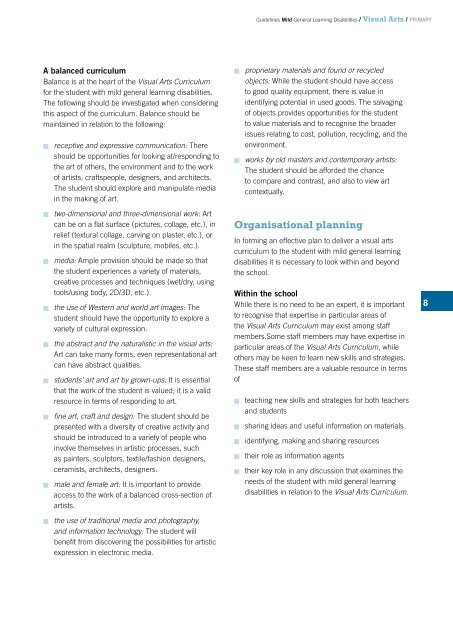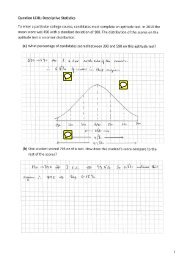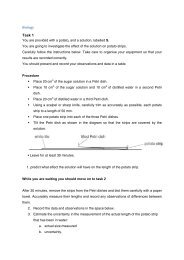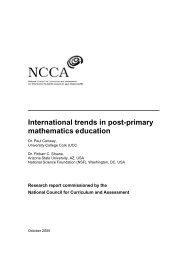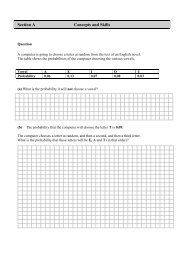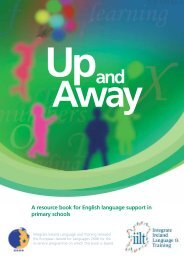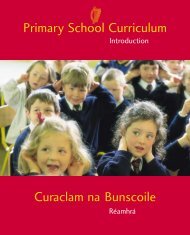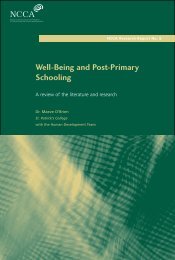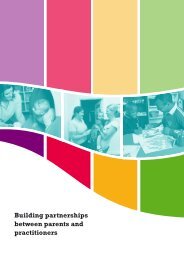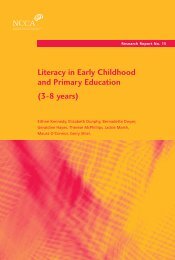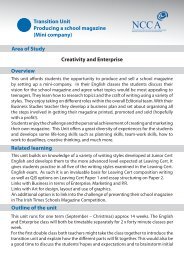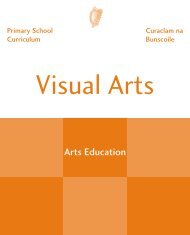Visual Arts - NCCA
Visual Arts - NCCA
Visual Arts - NCCA
You also want an ePaper? Increase the reach of your titles
YUMPU automatically turns print PDFs into web optimized ePapers that Google loves.
A balanced curriculum<br />
Balance is at the heart of the <strong>Visual</strong> <strong>Arts</strong> Curriculum<br />
for the student with mild general learning disabilities.<br />
The following should be investigated when considering<br />
this aspect of the curriculum. Balance should be<br />
maintained in relation to the following:<br />
n<br />
n<br />
n<br />
n<br />
n<br />
n<br />
n<br />
n<br />
n<br />
receptive and expressive communication: There<br />
should be opportunities for looking at/responding to<br />
the art of others, the environment and to the work<br />
of artists, craftspeople, designers, and architects.<br />
The student should explore and manipulate media<br />
in the making of art.<br />
two-dimensional and three-dimensional work: Art<br />
can be on a flat surface (pictures, collage, etc.), in<br />
relief (textural collage, carving on plaster, etc.), or<br />
in the spatial realm (sculpture, mobiles, etc.).<br />
media: Ample provision should be made so that<br />
the student experiences a variety of materials,<br />
creative processes and techniques (wet/dry, using<br />
tools/using body, 2D/3D, etc.).<br />
the use of Western and world art images: The<br />
student should have the opportunity to explore a<br />
variety of cultural expression.<br />
the abstract and the naturalistic in the visual arts:<br />
Art can take many forms, even representational art<br />
can have abstract qualities.<br />
students’ art and art by grown-ups: It is essential<br />
that the work of the student is valued; it is a valid<br />
resource in terms of responding to art.<br />
fine art, craft and design: The student should be<br />
presented with a diversity of creative activity and<br />
should be introduced to a variety of people who<br />
involve themselves in artistic processes, such<br />
as painters, sculptors, textile/fashion designers,<br />
ceramists, architects, designers.<br />
male and female art: It is important to provide<br />
access to the work of a balanced cross-section of<br />
artists.<br />
the use of traditional media and photography,<br />
and information technology: The student will<br />
benefit from discovering the possibilities for artistic<br />
expression in electronic media.<br />
n<br />
n<br />
proprietary materials and found or recycled<br />
objects: While the student should have access<br />
to good quality equipment, there is value in<br />
identifying potential in used goods. The salvaging<br />
of objects provides opportunities for the student<br />
to value materials and to recognise the broader<br />
issues relating to cost, pollution, recycling, and the<br />
environment.<br />
works by old masters and contemporary artists:<br />
The student should be afforded the chance<br />
to compare and contrast, and also to view art<br />
contextually.<br />
Organisational planning<br />
In forming an effective plan to deliver a visual arts<br />
curriculum to the student with mild general learning<br />
disabilities it is necessary to look within and beyond<br />
the school.<br />
Within the school<br />
While there is no need to be an expert, it is important<br />
to recognise that expertise in particular areas of<br />
the <strong>Visual</strong> <strong>Arts</strong> Curriculum may exist among staff<br />
members.Some staff members may have expertise in<br />
particular areas of the <strong>Visual</strong> <strong>Arts</strong> Curriculum, while<br />
others may be keen to learn new skills and strategies.<br />
These staff members are a valuable resource in terms<br />
of<br />
n<br />
n<br />
n<br />
n<br />
n<br />
Guidelines Mild General Learning Disabilities / <strong>Visual</strong> <strong>Arts</strong> / PRIMARY<br />
teaching new skills and strategies for both teachers<br />
and students<br />
sharing ideas and useful information on materials<br />
identifying, making and sharing resources<br />
their role as information agents<br />
their key role in any discussion that examines the<br />
needs of the student with mild general learning<br />
disabilities in relation to the <strong>Visual</strong> <strong>Arts</strong> Curriculum.


